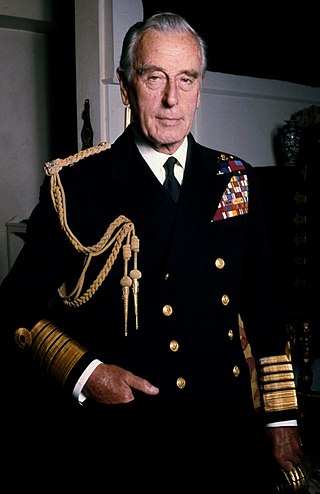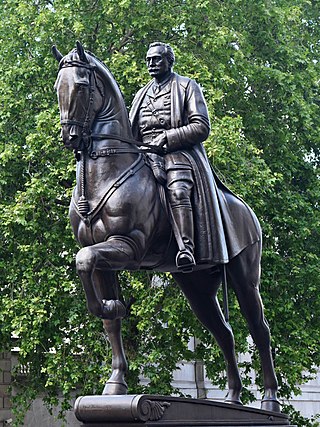
Admiral of the Fleet Louis Francis Albert Victor Nicholas Mountbatten, 1st Earl Mountbatten of Burma, commonly known as Lord Mountbatten, was a British statesman, naval officer, colonial administrator and close relative of the British royal family. He was born in the United Kingdom to the prominent Battenberg family. He was a maternal uncle of Prince Philip, Duke of Edinburgh, and a second cousin of King George VI. He joined the Royal Navy during the First World War and was appointed Supreme Allied Commander, South East Asia Command, in the Second World War. He later served as the last Viceroy of India and briefly as the first Governor-General of the Dominion of India.

Earl Mountbatten of Burma is a title in the Peerage of the United Kingdom, created in 1947 for Rear Admiral Louis Mountbatten, who in 1946 had been created the first Viscount Mountbatten of Burma. He was later promoted to Admiral of the Fleet.

Horse Guards Parade is a large parade ground off Whitehall in central London. It is the site of the annual ceremonies of Trooping the Colour, which commemorates the monarch's official birthday, and the Beating Retreat.

The House of Mountbatten is a British dynasty that originated as a British branch of the German princely Battenberg family. The name was adopted on 14 July 1917, three days before the British royal family changed its name from "Saxe-Coburg and Gotha" to "Windsor", by members of the Battenberg family residing in the United Kingdom, due to rising anti-German sentiment among the British public during World War I. The name is a direct Anglicisation of the German Battenberg, the name of a small town in Hesse. The titles of count and later prince of Battenberg had been granted in the mid-19th century to a morganatic branch of the House of Hesse-Darmstadt, itself a cadet branch of the House of Hesse.

František Bělský was a Czech-British sculptor.
Norton Louis Philip Knatchbull, 3rd Earl Mountbatten of Burma, known until 2005 as Lord Romsey and until 2017 as the Lord Brabourne, is a British peer. He is a second cousin of King Charles III.

Oscar Nemon was a Croatian sculptor who was born in Osijek, Croatia, but eventually settled in England. He is best known for his series of more than a dozen public statues of Sir Winston Churchill.

The Earl Haig Memorial is a bronze equestrian statue of the British Western Front commander Douglas Haig, 1st Earl Haig on Whitehall in Westminster, London. It was created by the sculptor Alfred Frank Hardiman and commissioned by Parliament in 1928. Eight years in the making, it aroused considerable controversy; the Field Marshal's riding position, his uniform, the horse's anatomy and its stance all drew harsh criticism. The inscription on the plinth reads 'Field Marshal Earl Haig Commander-in-Chief of the British Armies in France 1915–1918'.

The fourth plinth is the northwest plinth in Trafalgar Square in central London. It was originally intended to hold an equestrian statue of William IV, but remained empty due to lack of funds. For over 150 years, its use was debated; in 1998, the Royal Society for the encouragement of Arts, Manufactures and Commerce (RSA) commissioned three contemporary sculptures to be displayed temporarily on the plinth. Shortly afterwards, Chris Smith, Secretary of State for Culture, Media and Sport, commissioned Sir John Mortimer to seek opinions from public art commissioners, critics and members of the public as to its future. Mortimer's final report recommended that there continue to be a rolling programme of commissioned temporary artworks rather than settle permanently on one figure or idea.

The equestrian statue of Charles I at Charing Cross, London, England, is a work by the French sculptor Hubert Le Sueur, probably cast in 1633 during Charles’ lifetime. It is the oldest bronze statue in London and is considered the central point of the city.

The Royal Naval Division Memorial is a First World War memorial located on Horse Guards Parade in central London, and dedicated to members of the 63rd Division (RND) killed in that conflict. Sir Edwin Lutyens designed the memorial, which was unveiled on 25 April 1925—ten years to the day after the Gallipoli landings, in which the division suffered heavy casualties. Shortly after the war, former members of the division established a committee, chaired by one of their leading officers, Brigadier-General Arthur Asquith, to raise funds for a memorial. Progress was initially slow. The committee planned to incorporate its memorial into a larger monument proposed by the Royal Navy for Trafalgar Square. When the navy abandoned that project, the RND's committee decided to proceed independently. They engaged Lutyens, who, after negotiation with the Office of Works, produced a design for a fountain connected to the balustrade of the Admiralty Extension building.

The statue of the Earl Kitchener is an outdoor bronze statue by John Tweed depicting Herbert Kitchener, 1st Earl Kitchener, installed in 1926 and located on the south side of Horse Guards Parade in London, United Kingdom. The sculpture stands on a Portland stone plinth. It became a Grade II listed building in 1970.

Boadicea and Her Daughters is a bronze sculptural group in London representing Boudica, queen of the Celtic Iceni tribe, who led an uprising in Roman Britain. It is located to the north side of the western end of Westminster Bridge, near Portcullis House and Westminster Pier, facing Big Ben and the Palace of Westminster across the road. It is considered the magnum opus of its sculptor, the English artist and engineer Thomas Thornycroft. Thornycroft worked on it from 1856 until shortly before his death in 1885, sometimes assisted by his son William Hamo Thornycroft, but it was not erected in its current position until 1902.

The statue of the Duke of Devonshire is a Grade II-listed outdoor bronze sculpture of Spencer Cavendish, 8th Duke of Devonshire, the leader of three British political parties between 1875 and 1903, and is located at the entrance to Horse Guards Avenue, Whitehall, London, England. A work of the sculptor Herbert Hampton, it was unveiled in 1911.

The Memorial to the Brigade of Gurkhas on Horse Guards Avenue, Whitehall, London, was unveiled by Queen Elizabeth II on 3 December 1997. This was the first memorial to Gurkha soldiers in the United Kingdom, and was occasioned by transfer of their headquarters and training centre from Hong Kong to London in 1997. The sculptor was Philip Jackson, working from a statue of 1924 by Richard Reginald Goulden in the Foreign and Commonwealth Office, and the plinth was designed by Cecil Denny Highton.

The London Troops War Memorial, located in front of the Royal Exchange in the City of London, commemorates the men of London who fought in World War I and World War II.

The equestrian statue of Prince George, Duke of Cambridge is a life-size memorial by Adrian Jones, installed in Whitehall, London, England.

The statue of William Slim, 1st Viscount Slim in Whitehall, London, is a work of 1988–1993 by the sculptor Ivor Roberts-Jones. It is one of three memorials to British military leaders of World War II on Raleigh Green, outside the Ministry of Defence's Main Building, the others being Oscar Nemon's 1980 statue of Lord Montgomery and Roberts-Jones's statue of Lord Alanbrooke, erected later in 1993. Slim's bronze statue stands approximately 3 metres (9.8 ft) high on a pedestal of Portland stone.

The equestrian statue of Ferdinand Foch stands in Lower Grosvenor Gardens, London. The sculptor was Georges Malissard and the statue is a replica of another raised in Cassel, France. Foch, appointed Supreme Commander of the Allied Forces on the Western Front in the Spring of 1918, was widely seen as the architect of Germany's ultimate defeat and surrender in November 1918. Among many other honours, he was made an honorary Field marshal in the British Army, the only French military commander to receive such a distinction. Following Foch's death in March 1929, a campaign was launched to erect a statue in London in his memory. The Foch Memorial Committee chose Malissard as the sculptor, who produced a replica of his 1928 statue of Foch at Cassel. The statue was unveiled by the Prince of Wales on 5 June 1930. Designated a Grade II listed structure in 1958, the statue's status was raised to Grade II* in 2016.

The ceremonial funeral of Admiral of the Fleet The 1st Earl Mountbatten of Burma took place on Wednesday, 5 September 1979, at Westminster Abbey following his assassination by the Provisional Irish Republican Army on Monday, 27 August 1979, off the coast of the Mullaghmore Peninsula in County Sligo, Ireland.




















